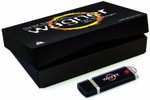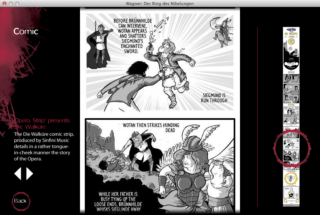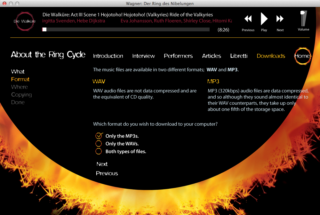|
Back
05/16/2014
Richard Wagner: Der Ring des Nibelungen
John Tomlinson (Wotan, Der Wanderer), Anne Evans (Brünnhilde), Siegfried Jerusalem (Siegfried), Günter von Kannen (Alberich), Graham Clark (Loge, Mime), Philip Kang (Fafner, Hagen), Poul Elming (Siegmund), Nadine Secunde (Sieglinde), Bodo Brinkmann (Donner, Gunther), Linda Finnie (Fricka, Valkyrie, Norn), Eva Johansson (Freia, Valkyrie), Eva-Maria Bundschuh (Gutrune, Valkyrie), Birgitta Svendén (Erda, Valkyrie, Norn), Matthias Hölle (Fasolt, Hunding), Kurt Schreibmayer (Froh), Waltraud Meier (Waltraute), Helmut Pampuch (Mime), Hilde Leidland (Woglinde, Waldvogel), Annette Küttenbaum (Wellgunde), Jane Turner (Flosshilde), Ruth Floeren (Valkyrie), Shirley Close (Valkyrie), Hitomi Katagiri (Valkyrie), Hebe Dijkstra (Valkyrie), Uta Priew (Norn), Chor und Orchester der Bayreuther Festspiele, Daniel Barenboim (conductor)
Recorded at the Bayreuth Festival, Germany (1991-1992)
Warner Classics 2564 64126-5 –
16GB USB Flash Drive with 320 kbps MP3 files and lossless WAV files, PC/Mac compatible desktop application

   
While “one ring to rule them all” may be from a different mythological saga, it is often the quest classical music collectors find themselves on when searching for a definitive Der Ring des Nibelungen. Such a quest is often a task of Tolkien proportions. Yet the critically-acclaimed Barenboim Ring is on most short lists of the great tetralogy and this re-release by Warner Classics one-ups the competition in a most intriguing way: presenting the entire performance on a 16GB USB flash drive. It is a presentation that is likely to turn off some while intriguing others. But if physical media is dying (as is often prognosticated), it’s a smart move on the company’s part to bridge the gap between download and CD.
The small box contains a handsomely imprinted USB drive that one can insert into a Mac or Windows PC and begin exploring away. There’s a brief text document with instructions, but one can quickly see that there are both a Mac and PC program at the root of the drive. Selecting the appropriate one launches the Ring app that is the gateway to all of the material.
For those who would rather do without the frills, there is an audio folder at the root of the drive that contains folders for both the MP3 and WAV files. One can simply copy one of those folders to their media player of choice and call it a day. Furthermore, if you have a means of playing files from a USB drive on your stereo system, it’s easy to plug the drive in, navigate and start listening. Although there are a few issues—more on that later.
The real draw here are the extra materials on the drive as one can buy either an MP3 or CD version of the entire recording for less than the price of this USB drive. Here, Warner Classics delivers quite satisfactorily (although I could do without the auto-playing “Ride of the Valkyries”). The app is easy to navigate and abundant in features. Each opera has its own menu that contains easy to select audio, a synopsis, indexed Leitmotifs, photos from the production, and a clever comic book style version made by Sinfini Music. While much of this material is aimed towards a novice or intermediate listener, the thoroughness of the presentation is interesting enough to appeal to even the most seasoned Ring devotees.

I found the comic for each opera to be one of the most fun features. Tongue-in-cheek, it is concise and true to the story and a neat addition. Also worth noting are the Leitmotifs. A brief musical notation is included for each (sorted by title), with notable appearances in any of the operas being listed below it. In and of itself, this is a most worthwhile feature and one of the more thoughtful applications of the technical capabilities of an app like this.

Upon further exploration, there is a wealth of material included that while not as creatively presented is nonetheless informative. A 15-minute video interview with John Tomlinson and Daniel Barenboim is great and the BBC’s 60-minute “Great Composers” video biography of Wagner is a generous addition. Performer bios, a Wagner bio, and short articles on the operas as well as PDF downloads of the libretti (complete booklets of the original CD releases) round out the additional material. In short, one could spend many hours with all this material.

Musically, this performance, captured over two seasons at Bayreuth, has been rightfully lauded as one of the finest Ring cycles ever recorded. Over twenty years later, there is little I can add as to the merits of this performance. The unifying force behind this recording is conductor Daniel Barenboim who leads with an undeniable understanding and vision of this music. In many ways, the force with which he conducts here is primal, meshing with production team and orchestra in a reading of Wagner’s masterpiece that sounds wholly organic in its pacing and revelatory in its ferocity.
The performances of both John Tomlinson and Siegfried Jerusalem are among the standouts on this recording. Both in the prime of their careers and their roles in the infancy of their developments, there is a vocal freshness that is exhilarating, a dramatic potency that is transfixing. To be sure, there are some performances here that are less than ideal, but there is a lot here to commend. This is an exhilarating Ring and remains so some 20 years later.
Unfortunately, the sound quality is dated. While airy and vivid, it is fatiguing and sounds, for lack of a better word, digital. Modern and previous recordings have surpassed this one as far as the listening experience is concerned. Stage movement and perspective is apparent and, depending on one’s preference, can be either distracting or engrossing. I find the dramatic benefits of the “live” performance outweigh any extraneous noises.
Finally, as I previously alluded to, despite the handsome presentation, when it comes down to just listening to this Ring the experience is less than ideal. The intention seems to be for the listener to enjoy the performance through the app. The drawbacks of doing so, however, are obvious. Most listeners purchasing music on a flash drive would expect to play the files directly from that drive or copy them to their music software. There are major problems with both options.

If I play the files directly from my drive using my four year-old Oppo BDP-93 the music has a gap between files. This appears to be a limitation of my player, but should be a consideration. Secondly, although the files are organized neatly by opera, act, and scene, the older WAV format does not support ID3 tags. While the MP3 files are neatly sortable inside a media player software like iTunes, the lossless files are not. This is a huge annoyance and, combined with the gapless issue, makes listening to the recording in lossless quality frustrating. The more popular FLAC would be a better choice for lossless file delivery with better compatibility for ID3 tags.
These concerns may be a deal-breaker for some, but it is encouraging to see Warner Classics deliver such a strong presentation of a beloved recording on a USB drive. The features are well-thought out, abundant, and enjoyable. The music itself is outstanding and among the most acclaimed Ring cycles ever recorded. Hopefully with a few tweaks to the playback experience this is a sign of good things to come from Warner Classics and others.
Matthew Richard Martinez
|